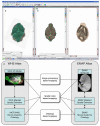Digital atlasing and standardization in the mouse brain
- PMID: 21304938
- PMCID: PMC3033370
- DOI: 10.1371/journal.pcbi.1001065
Digital atlasing and standardization in the mouse brain
Erratum in
- PLoS Comput Biol. 2011 Feb;7(2). doi: 10.1371/annotation/22c5808a-56cf-46e5-ba1b-456e838a5428. Larsen, Stephen D [corrected to Larson, Stephen D]
Conflict of interest statement
The authors have declared that no competing interests exist.
Figures






Comment in
-
Building a megabrain atlas.Nat Methods. 2011 Apr;8(4):290. doi: 10.1038/nmeth0411-290. Nat Methods. 2011. PMID: 21574273 No abstract available.
Similar articles
-
Multimodal, multidimensional models of mouse brain.Epilepsia. 2007;48 Suppl 4(Suppl 4):75-81. doi: 10.1111/j.1528-1167.2007.01244.x. Epilepsia. 2007. PMID: 17767578 Free PMC article.
-
The informatics of a C57BL/6J mouse brain atlas.Neuroinformatics. 2003;1(4):397-410. doi: 10.1385/NI:1:4:397. Neuroinformatics. 2003. PMID: 15043223
-
A segmentation protocol and MRI atlas of the C57BL/6J mouse neocortex.Neuroimage. 2013 Sep;78:196-203. doi: 10.1016/j.neuroimage.2013.04.008. Epub 2013 Apr 12. Neuroimage. 2013. PMID: 23587687
-
Discrepancies in stereotaxic coordinate publications and improving precision using an animal-specific atlas.J Neurosci Methods. 2017 Jun 1;284:15-20. doi: 10.1016/j.jneumeth.2017.03.019. Epub 2017 Apr 7. J Neurosci Methods. 2017. PMID: 28392415 Review.
-
Maps of the brain.Anat Rec. 2001 Apr;265(2):37-53. doi: 10.1002/ar.1057. Anat Rec. 2001. PMID: 11323769 Review.
Cited by
-
QUINT: Workflow for Quantification and Spatial Analysis of Features in Histological Images From Rodent Brain.Front Neuroinform. 2019 Dec 3;13:75. doi: 10.3389/fninf.2019.00075. eCollection 2019. Front Neuroinform. 2019. PMID: 31849633 Free PMC article.
-
Pursuit of precision medicine: Systems biology approaches in Alzheimer's disease mouse models.Neurobiol Dis. 2021 Dec;161:105558. doi: 10.1016/j.nbd.2021.105558. Epub 2021 Nov 10. Neurobiol Dis. 2021. PMID: 34767943 Free PMC article. Review.
-
Knowledge synthesis with maps of neural connectivity.Front Neuroinform. 2011 Nov 1;5:24. doi: 10.3389/fninf.2011.00024. eCollection 2011. Front Neuroinform. 2011. PMID: 22053155 Free PMC article.
-
Anatomical variability, multi-modal coordinate systems, and precision targeting in the marmoset brain.Neuroimage. 2022 Apr 15;250:118965. doi: 10.1016/j.neuroimage.2022.118965. Epub 2022 Feb 2. Neuroimage. 2022. PMID: 35122965 Free PMC article.
-
DHARANI: A 3D Developing Human-Brain Atlas Resource to Advance Neuroscience Internationally Integrated Multimodal Imaging and High-Resolution Histology of the Second Trimester.J Comp Neurol. 2025 Feb;533(2):e70006. doi: 10.1002/cne.70006. J Comp Neurol. 2025. PMID: 39905665 Free PMC article.
References
-
- Paxinos G, Watson C. The rat brain in stereotaxic coordinates. Academic Press; 2007. p. 456 p. - PubMed
-
- Schmahmann JD, Doyon J, McDonald D, Holmes C, Lavoie K, et al. Three-dimensional MRI atlas of the human cerebellum in proportional stereotaxic space. Neuroimage. 1999;10:233–260. - PubMed
-
- Chakravarty MM, Bertrand G, Hodge CP, Sadikot AF, Collins DL. The creation of a brain atlas for image guided neurosurgery using serial histological data. Neuroimage. 2006;30:359–376. - PubMed
-
- Ganser KA, Dickhaus H, Metzner R, Wirtz CR. A deformable digital brain atlas system according to Talairach and Tournoux. Med Image Anal. 2004;8:3–22. - PubMed
MeSH terms
Grants and funding
LinkOut - more resources
Full Text Sources
Other Literature Sources

